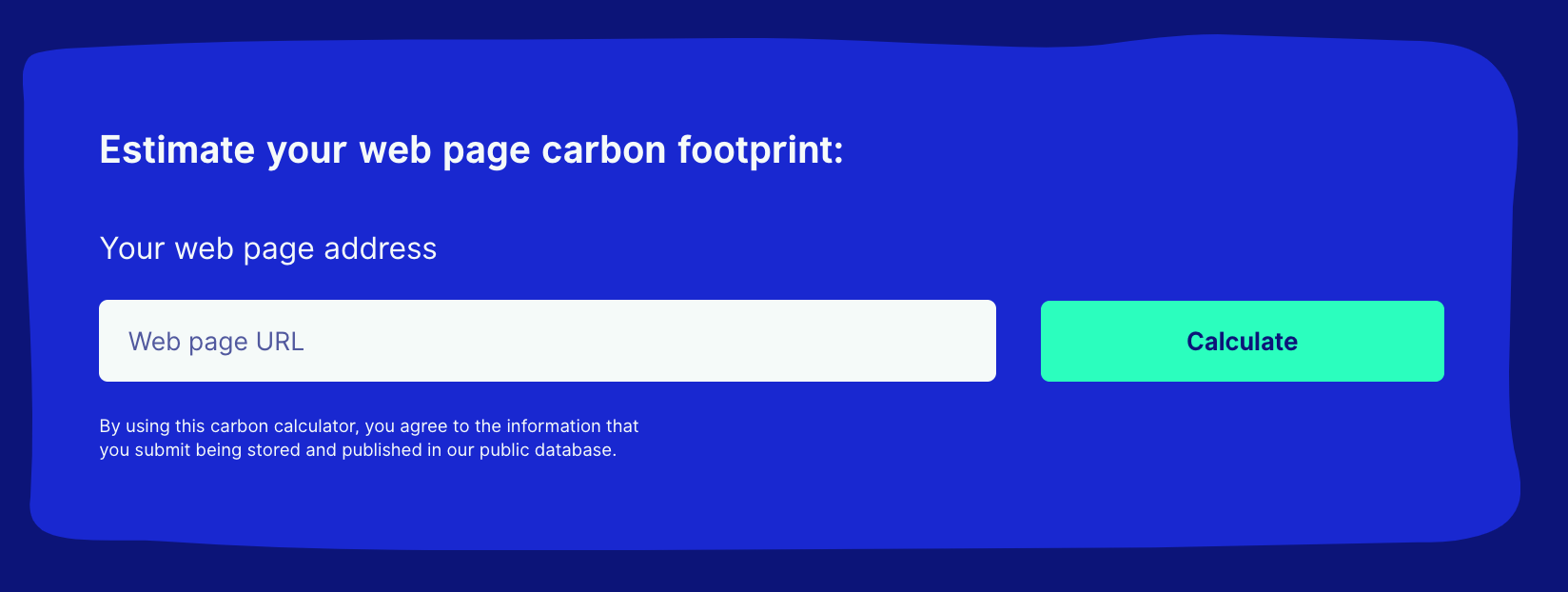How bad is my website?
According to Website Carbon, the internet consumes 416.2TWh of electricity per year, which is more than the entire UK. Also, although the energy needed for writing an email or one internet search is pretty tiny, about 4.1 billion people are now using the internet. Our websites live in data centres, usually, many miles away, so it can be tricky to get a good picture of the carbon emissions involved with keeping a professional online presence. Here, we aim to untangle some of the claims and fears around website carbon.
Before digital took over, the side effects of analogue streams of data were more tangible and noticeable. Today, data streams are pretty invisible and therefore not something we tend to take into account when designing and using digital tools.
How big or small the carbon footprint is from your website depends on how many visitors you get and how much data your website is hosting. If you were to build a website from scratch A "good", or low-carbon, website uses compressed images, lightweight formats, lean frameworks and efficient file formats. Website Carbon has a great resource here for more guidelines. They also provide a service by which you can measure the carbon footprint of your website. I also state the carbon footprint of the Green Screen website too, at the bottom of the page.
How big or small the carbon footprint is from your website depends on how many visitors you get and how much data your website is hosting. If you were to build a website from scratch A "good", or low-carbon, website uses compressed images, lightweight formats, lean frameworks and efficient file formats. Website Carbon has a great resource here for more guidelines. They also provide a service by which you can measure the carbon footprint of your website. I also state the carbon footprint of the Green Screen website too, at the bottom of the page.

https://www.websitecarbon.com/
The Eco-Friendly Web Alliance offers the world’s first eco standard for websites. It guides users how to keep to a 1g CO2e limit per web page, using green hosting and taking responsibility for page view emissions.
All website decarbonisation efforts are about reducing the amount of data that is sent across the network and stored on various machines in that network. Processes that all use, electricity day and night. According to httparchive, in 2010 the average webpage was 468KB in size, while today it is more than 2,000 KB.
Compare this with recent research by Basil Fighiera who calculated that a simple email emits 4 gCO2e, while an email with an attachment emits 35 gCO2e. Global Citizen says: "Compare the Market analyzed 10 of the most popular social media platforms and found that using TikTok generates the most emissions per minute of use at 2.63 grams of carbon dioxide, followed by Reddit (2.45 grams of CO2) and Pinterest (1.3 grams of CO2). Try the social media footprint calculator to find the carbon emissions of your average daily social media habits.
Unless you are responsible for a large website where you expect thousands of visitors every day or store vast amounts of files on your website, there are more impactful ways you can reduce your carbon emissions. However, with the knowledge that internet use is growing exponentially, here are some tips on how to keep your online presence and energy use under control.
The Eco-Friendly Web Alliance offers the world’s first eco standard for websites. It guides users how to keep to a 1g CO2e limit per web page, using green hosting and taking responsibility for page view emissions.
All website decarbonisation efforts are about reducing the amount of data that is sent across the network and stored on various machines in that network. Processes that all use, electricity day and night. According to httparchive, in 2010 the average webpage was 468KB in size, while today it is more than 2,000 KB.
Compare this with recent research by Basil Fighiera who calculated that a simple email emits 4 gCO2e, while an email with an attachment emits 35 gCO2e. Global Citizen says: "Compare the Market analyzed 10 of the most popular social media platforms and found that using TikTok generates the most emissions per minute of use at 2.63 grams of carbon dioxide, followed by Reddit (2.45 grams of CO2) and Pinterest (1.3 grams of CO2). Try the social media footprint calculator to find the carbon emissions of your average daily social media habits.
Unless you are responsible for a large website where you expect thousands of visitors every day or store vast amounts of files on your website, there are more impactful ways you can reduce your carbon emissions. However, with the knowledge that internet use is growing exponentially, here are some tips on how to keep your online presence and energy use under control.
Ways to reduce your website impact:
- The Green Web Foundation’s directory lists several website host producers that use renewable energy.
- Reduce the size of your images and avoid using videos.
- Delete unused material and sites.
- Use a content delivery network (CDN).
- Block bots that take up unnecessary traffic.
- Build a solar-powered website.

Sources:
https://www.websitecarbon.com/
https://www.itu.int/en/ITU-D/Statistics/Pages/stat/default.aspx
https://www.wholegraindigital.com/blog/website-energy-efficiency/
https://ecofriendlyweb.org/
https://www.thegreenwebfoundation.org/directory/
https://yoast.com/what-is-a-cdn/
https://solar.lowtechmagazine.com/2023/06/rebuilding-a-solar-powered-website/
https://www.bbc.co.uk/news/business-64623955
https://www.wired.co.uk/article/internet-carbon-footprint
https://www.websitecarbon.com/
https://www.itu.int/en/ITU-D/Statistics/Pages/stat/default.aspx
https://www.wholegraindigital.com/blog/website-energy-efficiency/
https://ecofriendlyweb.org/
https://www.thegreenwebfoundation.org/directory/
https://yoast.com/what-is-a-cdn/
https://solar.lowtechmagazine.com/2023/06/rebuilding-a-solar-powered-website/
https://www.bbc.co.uk/news/business-64623955
https://www.wired.co.uk/article/internet-carbon-footprint

